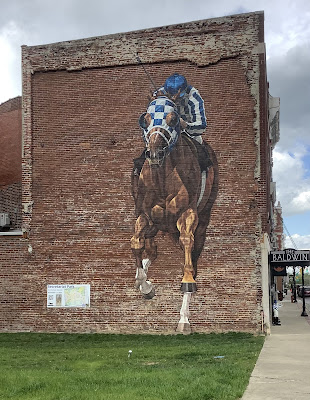The light was much dimmer in the forest when my alarm went off at 6:30 than it had been the day before when I set out from the motel in Central City at that early hour. I was surprised the foliage could make that much of a difference. Fifteen minutes later when I glanced at my watch, I was taken aback when it read 5:45. I had crossed into the Eastern time zone without being aware of it, though my iPad registered the time change. I was too far along in my packing to go back to sleep for forty-five minutes and instead could be happy for an early, early start, giving me a better chance to get to Lexington and beyond.
I arrived at the first library of the day in Bardstown just as it was opening. There were several others awaiting, including a mother with two young children. In the foyer was the usual display of notices of community interest on a shelf. The one with the largest, boldest type was titled Felon Expungement, something I’d never seen before. The rest room door had a sign warning of camera surveillance in response to vandalism. Fearing I may have ventured into a den of ne’er-do-wells, I went back outside and moved my bike by a window where I could keep an eye on it. A nice older gentleman engaged me in conversation, taking the edge off my concerns. He recommended an alternate route to Lexington with less traffic. After several minutes he wished me luck, and added, “I don’t envy you,” with the implication that he knew that maybe he should.
A few drops of rain and forecast of more for the next hour prolonged my stay at the library. The day remained overcast and cool with intermittent drops though never enough to more than dampen my clothes. The hilly terrain kept my average speed below eleven miles per hour, which I needed as a minimum to reach Lexington and get beyond it to find a place to camp, so I stopped ten miles outside the city when a vast unplanted pasture with a ring of trees around it presented itself.
It was a lucky oasis, as I was already in the Lexington sprawl. I was relieved to be able to pass through Lexington early on a Sunday morning rather than in the bustle of Saturday evening traffic. As I approached the big college town I came upon the first indication that I was in the state known for horse racing. It was a sign for Man O’ War Boulevard leading to Blue Grass Airport.
Man O’ War was considered the greatest horse in history until Secretariat came along, though ironically Man O’ War did not race the Kentucky Derby, as his trainer thought it was too long of a race for him. He went on to win the Belmont and the Preakness, the rest of the Triple Crown, setting a record time for the Preakness. He was so dominant, winning nineteen of twenty races, that the New York Times named him the athlete of the year in 1920 along with Babe Ruth.
I arrived at the first library of the day in Bardstown just as it was opening. There were several others awaiting, including a mother with two young children. In the foyer was the usual display of notices of community interest on a shelf. The one with the largest, boldest type was titled Felon Expungement, something I’d never seen before. The rest room door had a sign warning of camera surveillance in response to vandalism. Fearing I may have ventured into a den of ne’er-do-wells, I went back outside and moved my bike by a window where I could keep an eye on it. A nice older gentleman engaged me in conversation, taking the edge off my concerns. He recommended an alternate route to Lexington with less traffic. After several minutes he wished me luck, and added, “I don’t envy you,” with the implication that he knew that maybe he should.
A few drops of rain and forecast of more for the next hour prolonged my stay at the library. The day remained overcast and cool with intermittent drops though never enough to more than dampen my clothes. The hilly terrain kept my average speed below eleven miles per hour, which I needed as a minimum to reach Lexington and get beyond it to find a place to camp, so I stopped ten miles outside the city when a vast unplanted pasture with a ring of trees around it presented itself.
It was a lucky oasis, as I was already in the Lexington sprawl. I was relieved to be able to pass through Lexington early on a Sunday morning rather than in the bustle of Saturday evening traffic. As I approached the big college town I came upon the first indication that I was in the state known for horse racing. It was a sign for Man O’ War Boulevard leading to Blue Grass Airport.
Man O’ War was considered the greatest horse in history until Secretariat came along, though ironically Man O’ War did not race the Kentucky Derby, as his trainer thought it was too long of a race for him. He went on to win the Belmont and the Preakness, the rest of the Triple Crown, setting a record time for the Preakness. He was so dominant, winning nineteen of twenty races, that the New York Times named him the athlete of the year in 1920 along with Babe Ruth.
Just as in Lawrence in Kansas, home to another college basketball powerhouse that I passed through earlier in the trip, there was a strong element of homelessness here. Older women were pushing around shopping cards loaded with all their earthly possessions. Others were huddled by piles of their belongings.










No comments:
Post a Comment